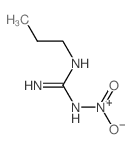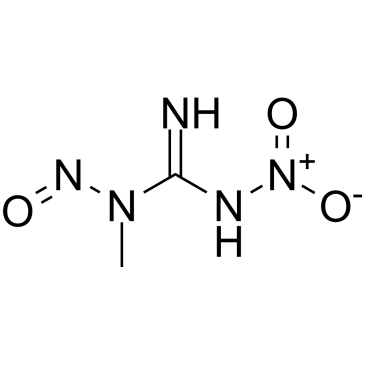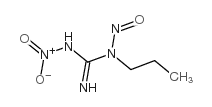Guanidine,N-nitro-N'-propyl- (9CI)
Modify Date: 2023-01-31 17:36:21

Guanidine,N-nitro-N'-propyl- (9CI) structure
|
Common Name | Guanidine,N-nitro-N'-propyl- (9CI) | ||
|---|---|---|---|---|
| CAS Number | 35091-64-6 | Molecular Weight | 146.14800 | |
| Density | 1.35g/cm3 | Boiling Point | 270.7ºC at 760mmHg | |
| Molecular Formula | C4H10N4O2 | Melting Point | N/A | |
| MSDS | N/A | Flash Point | 117.5ºC | |
| Name | 1-nitro-2-propylguanidine |
|---|---|
| Synonym | More Synonyms |
| Density | 1.35g/cm3 |
|---|---|
| Boiling Point | 270.7ºC at 760mmHg |
| Molecular Formula | C4H10N4O2 |
| Molecular Weight | 146.14800 |
| Flash Point | 117.5ºC |
| Exact Mass | 146.08000 |
| PSA | 93.73000 |
| LogP | 1.10680 |
|
Version 1.2
Regulation (EC) No 1907/2006 1 - Product and Company Information Product Name1-NITRO-3-PROPYLGUANIDINE - 250 MG 2 - Hazards Identification SPECIAL INDICATION OF HAZARDS TO HUMANS AND THE ENVIRONMENT Highly flammable. Irritating to eyes, respiratory system and skin.
3 - Composition/Information on Ingredients Product NameCAS #EC noAnnex I Index Number 1-NITRO-3-PROPYLGUANIDINE35091-64-6 NoneNone FormulaC4H10N4O2 SynonymsN-Propyl-N'-nitroguanidine 4 - First Aid Measures AFTER INHALATION If inhaled, remove to fresh air. If not breathing give artificial respiration. If breathing is difficult, give oxygen. AFTER SKIN CONTACT In case of contact, immediately wash skin with soap and copious amounts of water. AFTER EYE CONTACT In case of contact, immediately flush eyes with copious amounts of water for at least 15 minutes. AFTER INGESTION If swallowed, wash out mouth with water provided person is conscious. Call a physician. 5 - Fire Fighting Measures EXPLOSION DATA Dust Potential: This material, like most materials in powder ALDRICHwww.molbase.com form, is capable of creating a dust explosion. EXTINGUISHING MEDIA Suitable: Use approved class D extinguishers or smother with dry sand, dry ground limestone, or dry clay. SPECIAL RISKS Specific Hazard(s): Flammable solid. Emits toxic fumes under fire conditions. SPECIAL PROTECTIVE EQUIPMENT FOR FIREFIGHTERS Wear self-contained breathing apparatus and protective clothing to prevent contact with skin and eyes. 6 - Accidental Release Measures PERSONAL PRECAUTION PROCEDURES TO BE FOLLOWED IN CASE OF LEAK OR SPILL Evacuate area. Shut off all sources of ignition. PROCEDURE(S) OF PERSONAL PRECAUTION(S) Wear self-contained breathing apparatus, rubber boots, and heavy rubber gloves. METHODS FOR CLEANING UP Cover with dry-lime, sand, or soda ash. Place in covered containers using non-sparking tools and transport outdoors. Ventilate area and wash spill site after material pickup is complete. 7 - Handling and Storage HANDLING Directions for Safe Handling: Avoid breathing dust. Avoid contact with eyes, skin, and clothing. Avoid prolonged or repeated exposure. Handle under nitrogen. STORAGE Conditions of Storage: Keep tightly closed. Store in a cool dry place. SPECIAL REQUIREMENTS: Heat- and air-sensitive. 8 - Exposure Controls / Personal Protection ENGINEERING CONTROLS Safety shower and eye bath. Mechanical exhaust required. Use nonsparking tools. GENERAL HYGIENE MEASURES Wash contaminated clothing before reuse. Wash thoroughly after handling. PERSONAL PROTECTIVE EQUIPMENT Respiratory Protection: Use respirators and components tested and approved under appropriate government standards such as NIOSH (US) or CEN (EU). Where risk assessment shows air-purifying respirators are appropriate use a full-face respirator with multi-purpose combination (US) or type ABEK (EN 14387) respirator cartridges as a backup to engineering controls. If the respirator is the sole means of protection, use a full-face supplied air respirator. ALDRICHwww.molbase.com Hand Protection: Compatible chemical-resistant gloves. Eye Protection: Chemical safety goggles. 9 - Physical and Chemical Properties pH N/A BP/BP RangeN/A MP/MP RangeN/A Flash PointN/A FlammabilityN/A Autoignition TempN/A Oxidizing Properties N/A Explosive Properties N/A Explosion LimitsN/A Vapor PressureN/A Partition Coefficient N/A ViscosityN/A Vapor DensityN/A Saturated Vapor Conc. N/A Evaporation RateN/A Bulk DensityN/A Decomposition Temp.N/A Solvent ContentN/A Water ContentN/A Surface TensionN/A ConductivityN/A Miscellaneous DataN/A SolubilityN/A 10 - Stability and Reactivity STABILITY Conditions of Instability: Heat. Air. Materials to Avoid: Strong oxidizing agents. 11 - Toxicological Information RTECS NUMBER: MF4650000 SIGNS AND SYMPTOMS OF EXPOSURE To the best of our knowledge, the chemical, physical, and toxicological properties have not been thoroughly investigated. ROUTE OF EXPOSURE Inhalation: Material is irritating to mucous membranes and upper respiratory tract. Multiple Routes: Causes eye and skin irritation. May be harmful by inhalation, ingestion, or skin absorption. CHRONIC EXPOSURE - MUTAGEN Hamster 2 GM/L 48H Cell Type: fibroblast Cytogenetic analysis 12 - Ecological Information No data available. ALDRICHwww.molbase.com 13 - Disposal Considerations SUBSTANCE DISPOSAL Dissolve or mix the material with a combustible solvent and burn in a chemical incinerator equipped with an afterburner and scrubber. Observe all federal, state, and local environmental regulations. 14 - Transport Information RID/ADR Non-hazardous for road transport. IMDG Non-hazardous for sea transport. IATA Non-hazardous for air transport. 15 - Regulatory Information CLASSIFICATION AND LABELING ACCORDING TO EU DIRECTIVES INDICATION OF DANGER: F-Xi Highly Flammable. Irritant. R-PHRASES: 11-36/37/38 Highly flammable. Irritating to eyes, respiratory system and skin. S-PHRASES: 16-26-36 Keep away from sources of ignition - no smoking. In case of contact with eyes, rinse immediately with plenty of water and seek medical advice. Wear suitable protective clothing. Caution: Substance not yet fully tested (EU). COUNTRY SPECIFIC INFORMATION Germany WGK: 3 Self-Classification 16 - Other Information WARRANTY The above information is believed to be correct but does not purport to be all inclusive and shall be used only as a guide. The information in this document is based on the present state of our knowledge and is applicable to the product with regard to appropriate safety precautions. It does not represent any guarantee of the properties of the product. Inc., shall not be held liable for any damage resulting from handling or from contact with the above product. See reverse side of invoice or packing slip for additional terms and conditions of sale. Copyright 2010 Co. License granted to make unlimitedpaper copies for internal use only. DISCLAIMER For R&D use only. Not for drug, household or other uses. ALDRICHwww.molbase.com SECTION 16 - ADDITIONAL INFORMATION N/A |
CHEMICAL IDENTIFICATION
HEALTH HAZARD DATAACUTE TOXICITY DATAMUTATION DATA
|
| HS Code | 2925290090 |
|---|
|
~% 
Guanidine,N-nit... CAS#:35091-64-6 |
| Literature: Skinner,W.A. et al. Journal of Medicinal and Pharmaceutical Chemistry, 1960 , vol. 2, p. 299 - 333 |
|
~% 
Guanidine,N-nit... CAS#:35091-64-6 |
| Literature: Fishbein; Gallaghan Journal of the American Chemical Society, 1954 , vol. 76, p. 1877 |
|
~% 
Guanidine,N-nit... CAS#:35091-64-6 |
| Literature: Iwahara; Yanagimachi; Kamiya; Nakadate; Suzuki Chemical and pharmaceutical bulletin, 1971 , vol. 19, # 9 p. 1914 - 1918 |
| HS Code | 2925290090 |
|---|---|
| Summary | 2925290090 other imines and their derivatives; salts thereof。Supervision conditions:None。VAT:17.0%。Tax rebate rate:9.0%。MFN tariff:6.5%。General tariff:30.0% |
| 3-nitro-1-propylguanidine |
| 3-Nitro-1-propyl-guanidin |
| GUANIDINE,1-NITRO-3-PROPYL |
| 1-nitro-3-propylguanidine |
| 1-Propyl-3'-nitro-guanidin |
| N-nitro-N'-propyl-guanidine |
| Guanidine,N-nitro-N'-propyl |
| 1-(n-Propyl)-3-nitroguanidin |
| N-Propyl-N'-nitroguanidine |




 CAS#:13010-07-6
CAS#:13010-07-6